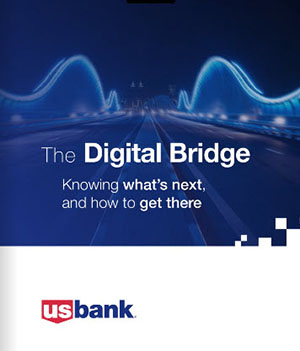Learn how data and analytics can help streamline the operational and strategic functions of your treasury, including liquidity and cash flow management.

In many ways, the day-to-day tasks of managing a treasury for an organization are similar to how you manage your personal finances. You closely track the inflow and outflow of your money. When you have extra cash for any period of time, you strategically invest or save it. And you try to maximize the benefit of your money by making smarter decisions.
The scale is just much larger for corporate treasurers and treasury managers. And the processing tools needed to turn raw data into actionable insights are considerably more robust than the math used at home. Data is the underlying raw information created while doing business. Analytics – the insights gained from reviewing and examining all your data – should help streamline the operational and strategic functions of your organization.
The analytics software continuum
Building your organization’s analytics program requires expanding how you track data and determining what tools you use to harmonize and mine the data to make it actionable. Here’s how the use of technology will likely evolve as you go from a simple tracker to a multi-stream analytics master.
Here are four ways that using data can help you streamline the operational and strategic elements of your treasury.
Strategy 1: Optimize working capital
Let’s say that you send payments to your bank and get a report that 80 percent of the payments are 10 days ahead of their invoicing due dates. That data can be useful for your operations: Adjusting the timing of these payments can help optimize your working capital. That money could be reallocated in your company to fund more pressing matters, including other payments.
“Data relates stories, and in this case the story is that you may have excess cash in the coming week, and if you knew how much excess cash you are likely to have, you can plan ahead and deploy those funds more efficiently,” says U.S. Bank Global Treasury Management Senior Vice President and Head of Digital Transformation, Vipul Kaushal. “That would be a good actionable insight–you can change your cash management activities based on that. Either you start taking advantage of the early payments you’re making by requesting a discount from your vendor, or you can reduce your working capital and invest excess cash.” Overall, making a change will help you optimize the amount of funding you need for your organization.
Strategy 2: Manage currency exposure to reduce risk
Analytics can help you see the trends and risk in your foreign currency payments and receipts. Currency hedging involves the purchase or sale of currency for delivery at a future date. This allows you to lock in an exchange rate or buy insurance against adverse changes in exchange rates. By reviewing the data, you can make more informed decisions about how much currency risk your organization faces and how best to act and reduce that risk.
“If all of your receipts are coming in British pounds (GBP), but your vendor payments are due in dollars (USD), your profit margins will be impacted by changes in the GBP/USD exchange rate. Many companies elect to hedge this risk,” says Chris Braun, managing director and head of FX Sales at U.S. Bank. By better analyzing the data, you can gain a deeper understanding of your exposures and make better decisions on how much to hedge. “If the exchange rate between pounds and dollars moves adversely, you’ve protected your margins,” Braun says.
Strategy 3: Monitor payments & trends
Now let’s say your typical biweekly payroll runs around $500,000, but it fluctuates every time you send it to the bank because of temporary staff and additional consulting fees. Using insights derived from your analytics, your bank might be able to track all of your previous payroll files and establish an average. If your next payroll week is much higher than, say, your last 12-week average, you could get a message alerting you to the inconsistency.
“If the bank gets a file worth a million dollars that says you have 750 employees, that would be a red flag,” Kaushal says. “You would know that you didn’t hire 250 employees last week. Maybe there’s an error in the system or maybe there’s a fraud, but whatever the issue, you would immediately know so that you can halt the payroll and investigate. Operational uses of analytics like this are critical to the ongoing health of your organization.”
Strategy 4: Benchmark for efficiency
Your analytics dashboards can be set to trigger alerts based on the number of manual payments or payments exceptions, which can help you benchmark your processes for efficiency.
“You might get a report saying that, in your peer group, only 5 percent of the payments are being stopped because of human error, while its 25 percent in your case,” Kaushal says. “That would provide an opportunity for you to improve your operational process.”
Build a digital bridge
Collecting the right data creates visibility into what’s happening at your organization. However, converting that data and visibility into actionable insights is what makes analytics so much more powerful.
Digital solutions can optimize treasury by building a bridge from data and analytics toward insights. Yet that is only one of many ways a digital transformation can accelerate a company's strategic journey toward short-, mid- and long-term goals.
“We can help treasury managers and corporate treasurers make better decisions,” Kaushal says. “They can improve their own internal processes, how they conduct their banking operations, or how they perform against their peer group.”
Explore the Digital Bridge: Download our e-book
For more information on how your business can best track your data and analytics,contact your banking relationship manager.



































